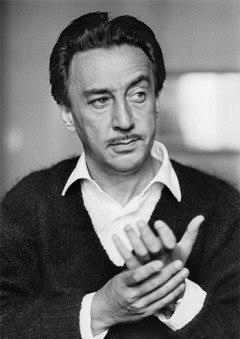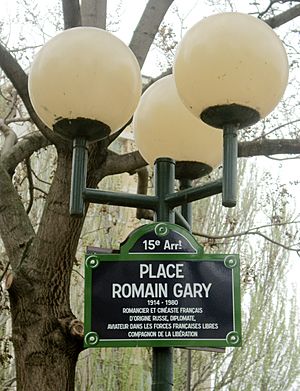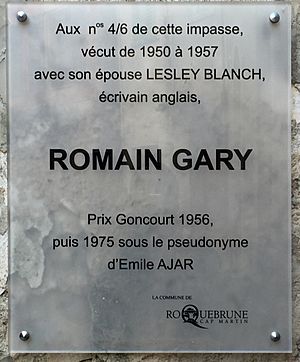Romain Gary facts for kids
Quick facts for kids
Romain Gary
|
|
|---|---|

Gary in 1961
|
|
| Born | Roman Kacew 21 May 1914 Vilnius, Vilna Governorate, Lithuania |
| Died | 2 December 1980 (aged 66) Paris, France |
| Pen name | Romain Gary, Émile Ajar, Fosco Sinibaldi, Shatan Bogat |
| Occupation | Diplomat, pilot, writer |
| Language | French, English |
| Nationality | French |
| Citizenship | Russian Empire France (since 1935) |
| Education | Law |
| Alma mater | Faculté de droit d'Aix-en-Provence Paris Law Faculty |
| Period | 1945–1979 |
| Genre | Novel |
| Notable works | Les racines du ciel La vie devant soi |
| Notable awards | Prix Goncourt (1956 and 1975) |
| Spouse |
Lesley Blanch
(m. 1944; div. 1961) |
| Children | 1 |
|
|
|
Romain Gary (born Roman Kacew, 21 May 1914 – 2 December 1980) was a famous French writer, diplomat, film director, and a pilot during World War II. He is the only author ever to win the important Prix Goncourt literary award twice. He won it once under his own name and again under the pen name Émile Ajar. He is seen as a very important writer in French literature from the second half of the 20th century. He was married to Lesley Blanch, and later to Jean Seberg.
Contents
Early Life and Education
Romain Gary was born Roman Kacew in Vilnius, which was part of the Russian Empire at the time. In his books, he often told different stories about his parents and his childhood. His mother, Mina Owczyńska, was a Jewish actress. His father, Arieh-Leib Kacew, was a businessman. They divorced in 1925.
Gary later said that his real father was a famous actor named Ivan Mosjoukine. His mother had worked with Mosjoukine, and Gary looked a lot like him. This story appears in his book Promise at Dawn.
In 1915, his family was sent to central Russia, where they stayed until 1920. They then returned to Vilnius before moving to Warsaw. When Gary was 14, he and his mother moved to Nice, France. Gary studied law in Aix-en-Provence and then in Paris. He also learned to fly planes in the French Air Force.
Military Service and Diplomatic Career
Gary wanted to be an officer in the French Air Force. However, he believed he was not made an officer because he was seen as a foreigner and was Jewish. Despite this, he became a sergeant in 1940.
During World War II, Gary was a brave pilot. He was lightly wounded in 1940. When France surrendered, he decided to join General de Gaulle's Free French forces in England. He flew many missions across Africa and was promoted. He even helped his pilot land a plane safely after the pilot was temporarily blinded. This act of bravery was even featured in a BBC interview and a newspaper article.
Gary finished the war as a captain. He received many medals for his courage, including the Compagnon de la Libération and commander of the Légion d'honneur. In 1945, he published his first novel, Éducation européenne.
After the war, Gary became a diplomat for France. A diplomat represents their country in other nations. He worked in places like Bulgaria, Switzerland, and New York, where he worked at the French Mission to the United Nations. From 1956 to 1960, he was the French Consul General in Los Angeles, where he got to know Hollywood.
Literary Achievements
Romain Gary was a very popular and productive writer in France. He wrote more than 30 novels, essays, and memoirs. Some of these he wrote using different names, called pseudonyms.
He is famous for being the only person to win the Prix Goncourt twice. This award is usually given only once to an author. Gary first won it in 1956 for his book Les racines du ciel. Later, in 1975, he won it again for La vie devant soi. However, he published this second book under the name Émile Ajar. The judges of the award did not know it was Gary. Gary's cousin's son, Paul Pavlowitch, pretended to be Émile Ajar for a while. Gary later revealed the truth in a book published after his death, called Vie et mort d'Émile Ajar.
Besides Émile Ajar, Gary also used other pen names like Shatan Bogat and Fosco Sinibaldi.
Gary was also involved in films. He wrote the screenplay for the movie The Longest Day. He also co-wrote and directed the film Kill! (1971), which starred his wife at the time, Jean Seberg.
Personal Life
Romain Gary's first wife was the British writer and journalist Lesley Blanch. They were married from 1944 to 1961. From 1962 to 1970, Gary was married to the American actress Jean Seberg. They had a son named Alexandre Diego Gary. His son said that Gary was often busy with his writing and seemed distant as a father.
Romain Gary was cremated, and his ashes were scattered in the Mediterranean Sea near Roquebrune-Cap-Martin.
Legacy
Romain Gary's name has been given to several places and institutions in France. These include a street in Paris, the Nice Heritage Library, and the French Institute in Jerusalem. His work is also part of the important Bibliothèque de la Pléiade collection.
In 2022, an actor named Denis Ménochet played Gary in a film called White Dog. This movie was based on Gary's 1970 book.
Filmography
As Screenwriter
- 1958: The Roots of Heaven
- 1962: The Longest Day
- 1978: La vie devant soi
As Actor
- 1936: Nitchevo – Le jeune homme au bastingage
- 1967: The Road to Corinth – (uncredited)
As Director
- 1968: Birds in Peru (Birds in Peru) starring Jean Seberg
- 1971: Kill! Kill! Kill! Kill! also starring Jean Seberg
Images for kids
See also
 In Spanish: Romain Gary para niños
In Spanish: Romain Gary para niños






